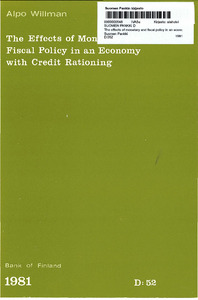The effects of monetary and fiscal policy in an economy with credit rationing
Willman, Alpo (01.06.1981)
Numero
52Julkaisija
Bank of Finland
1981
Julkaisun pysyvä osoite on
https://urn.fi/URN:NBN:fi:bof-201808081943Tiivistelmä
There are many reasons for claiming that the market for financial assets is not well-developed in Finland. The security market is so "narrow" that security issues play no essential role in the financing of investment, bank loans being the principal source of external finance. This also implies that deposits are the only substitute for government bonds in households' portfolios. As, in addition, deposit and loan rates are controlled by the central bank and are thus insensitive to market disequilibria, no mechanism exists for equilibrating the credit market. For this reason the Finnish economy can be called a creditrationing economy.
The banks' borrowing from the central bank plays a major role in the monetary policy pursued by the central bank. The central bank can affect the tightness of the credit market by regulating the terms of the banks' central bank debt. Under the system which was predominant until 1975, there were specified limits up to which each bank could borrow from the central bank at a basic discount rate. Penalty rates were applied on borrowing in excess of these basic quotas. A call money market, on which both the commercial banks and the central bank operate, was introduced in 1975. This market is another channel through which the central bank can supply funds to the banks.
It is clear that the familiar IS-LM framework, which assumes a perfect capital market, is not valid in the institutional setting described above. The purpose of this paper is to formulate an IS-LM analogy suitable for an economy characterized above. Two earlier attempts in this field are those by Koskela (1979a,b) and Oksanen (1980). One fundamental difference between their approaches and the present one is that their frameworks lack links from flow variables to stock variables. Hence they were able to study only the short-term comparative static properties of their models. However, from the point of view of the crowdingout phenomenon, the long-run stability pröperties of the models are of great importance.
In this respect, the framework specified in this paper is intended to be more thorough. The ad-hoc nature of the model is lessened by the fact that the assumptions concerning the behaviour of the banks and 'the nature of the credit market have been explicitly taken into account in the specifiQation of the financial sector. The banks are assumed to be either profit maximizers or maximizers of the volume of lending under a minimum profit constraint. The credit market is assumed to be heterogeneous, i.e., there are at the same time both rationed and unrationed clients. In a heterogeneous market, the effective supply of loans is always smaller than the notional demand for credit. Thus, credit rationing prevails all the time, with only the degree of rationing varying.
The banks' borrowing from the central bank plays a major role in the monetary policy pursued by the central bank. The central bank can affect the tightness of the credit market by regulating the terms of the banks' central bank debt. Under the system which was predominant until 1975, there were specified limits up to which each bank could borrow from the central bank at a basic discount rate. Penalty rates were applied on borrowing in excess of these basic quotas. A call money market, on which both the commercial banks and the central bank operate, was introduced in 1975. This market is another channel through which the central bank can supply funds to the banks.
It is clear that the familiar IS-LM framework, which assumes a perfect capital market, is not valid in the institutional setting described above. The purpose of this paper is to formulate an IS-LM analogy suitable for an economy characterized above. Two earlier attempts in this field are those by Koskela (1979a,b) and Oksanen (1980). One fundamental difference between their approaches and the present one is that their frameworks lack links from flow variables to stock variables. Hence they were able to study only the short-term comparative static properties of their models. However, from the point of view of the crowdingout phenomenon, the long-run stability pröperties of the models are of great importance.
In this respect, the framework specified in this paper is intended to be more thorough. The ad-hoc nature of the model is lessened by the fact that the assumptions concerning the behaviour of the banks and 'the nature of the credit market have been explicitly taken into account in the specifiQation of the financial sector. The banks are assumed to be either profit maximizers or maximizers of the volume of lending under a minimum profit constraint. The credit market is assumed to be heterogeneous, i.e., there are at the same time both rationed and unrationed clients. In a heterogeneous market, the effective supply of loans is always smaller than the notional demand for credit. Thus, credit rationing prevails all the time, with only the degree of rationing varying.
